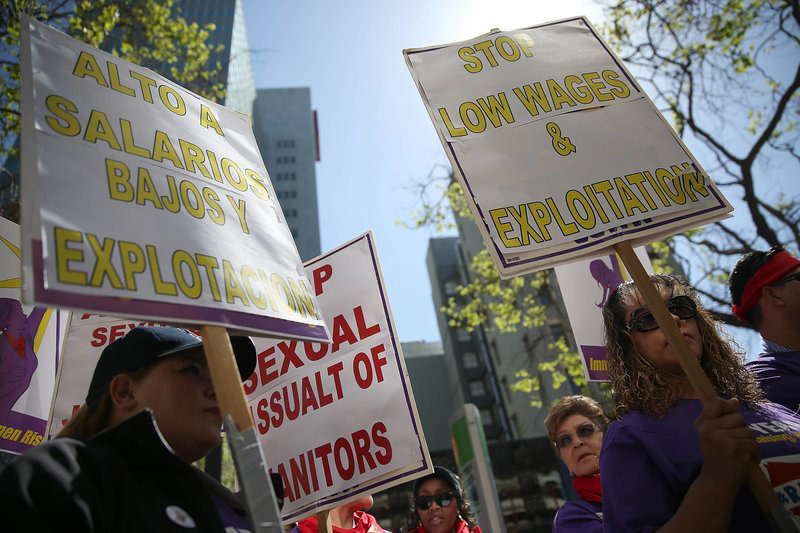
2016年3月31日,在加利福尼亚州的奥克兰,工会的工人举着标语游行,他们希望加州的最低时薪在2022年之前提高到15美元。米尔顿·莫斯科维茨相信,美国的最佳职场能够给其他公司带来重要的经验。在他的启发下,美国职场办公室成立,并计划根据公司最佳的职场实践发布一份评分榜单。图片来源:Justin Sullivan—Getty Images
|
1984年,米尔顿·莫斯科维茨与罗伯特·列弗宁首次出版了作品《美国最适合工作的100家公司》(The 100 Best Companies to Work for in America)。直至今年3月5日逝世,莫斯科维茨一直相信更好的职场会造就更好的公司。他的创举是把针对数百万个员工的调查数据转化为职场创新的故事。这些故事实在引人入胜,以至于管理者开始纷纷关注这一榜单,并力争在榜单上占有一席之地。 莫斯科维茨坚信,美国的最佳职场能够给其他公司带来重要的经验。他的信念帮助促成了一个新的联邦机构诞生。推广最佳职场实践给公司带来的帮助,似乎就像农业推广服务给农业带来的帮助一样。为了应对爱尔兰大饥荒,Pioneered in Ireland应运而生,推广员组织农民交换信息和技能以促进生产。在克林顿执政初期,我想知道政府能否采用类似的做法改善美国职场? 劳工部长提名人罗伯特·赖克相信我们可以做到。他认为,劳工部不仅应该收集关键经济数据、执行办公场所标准、为培训项目筹措资金,还应该分析和推广那些给小时工提供培训和激励的优秀职场。从1993年到1996年,劳工部建立了美国职场办公室(Office of the American Workplace)。它和莫斯科维茨的理念一致,相信伟大的公司与员工心连心。我帮助劝说赖克成立了这一机构,并被任命为它的主任。 赖克提出了挑战,要求办公室建立公开的评判标准,根据各公司的职场实践给它们打分。他希望华尔街奖励那些支持培训、多样化、薪酬平等,反对裁员、外包和关闭工厂的公司。 我喜欢这个公开评判标准的想法(目前仍然如此),不过我们只是一家很小的机构,而当时美国有大约600万个办公场所。此外,我也不确定职场实践和公司业绩之间的关联是否足够明显到让华尔街给予关注。 商业的成功无法用单一因素来解释。产品和服务创新、成本竞争力、明智的领导——以及时间和运气——都会影响公司业绩。例如,直到20世纪90年代早期,IBM还在培训员工上大量投入,坚持通过损耗而不是裁员来缩减员工规模。公司还把女性和少数族裔提拔至管理层。但是他们在个人电脑的革新上出现了重大的管理失误,遭遇了惨痛的亏损。相反,微软(Microsoft)在1993年至1994年间增长了约20%,但他们在改善职场上没有任何明显的创举。我担心,这样一份推荐IBM而不是微软的职场质量指标在券商那里会显得无足轻重。 然而,赖克没有那么容易被劝阻。在向他推销了有关工作场所非常重要的想法之后,我就没有了推诿的立场。所以我建议找那些我们认为可能会用到这种职场指数的首席执行官和华尔街交易员测试一番。赖克推荐了贝尔斯登(Bear Stearns)的首席执行官艾伦·格林伯格和强生公司(Johnson & Johnson)的首席执行官詹姆斯·伯克。我推荐了投资者沃伦·巴非特和黑石集团(Blackstone Group)的董事长彼得·彼得森。 最后,我们把上述这些和另外一些美国资本界的巨头请到了一起,看看他们对这一职场质量指数有何评价。赖克和我的脑海中满是莫斯科维茨的想法,我们解释了这个指数的机制、数据的来源,以及希望投资者如何利用这一信息。随后,每位领袖都耐心地解释我们的想法为什么不可行。理由之一是华尔街交易的是公司,而不是职场。强大而充满信任的职场文化和公司业绩之间存在一定联系,但不能完全确保最终业绩的强势。毕竟,杰克·韦尔奇治下的通用电气(General Electric)就是通过裁员和生产外包扩大了利润。 即使华尔街对这一信息不买账,但认可那些美国最具创新力的职场仍然意义十足。我联系了莫斯科维茨,得到了他的建议。劳工部能否设立一个类似于马尔科姆·鲍德里奇国家质量奖(Malcolm Baldrige National Quality Award)的奖项?他担心政府的奖项太容易被政治化。那么,像《财富》杂志对美国的大公司那样,颁布一份最佳职场的年度榜单呢?让一家商业杂志公布他的榜单,相当于结合了评分和颁奖的意味。莫斯科维茨采纳了这一想法。1998年,《财富》杂志开始根据他的调查与分析,发布一年一度的“最佳职场100强”榜单。 一些公司继续质疑登上这份“最佳职场”榜单的商业价值。然而,2010年《金融经济学刊》(Journal of Financial Economics)上的一份研究根据莫斯科维茨遴选的公司建立了一个投资组合,并针对公司特征、领域和离群值等因素进行了统计控制。作者得出结论称,“最佳职场”投资组合的表现显著优于行业基准水平,因为股市没有充分评判尽职尽责的员工等无形资产。事实证明,莫斯科维茨一直是对的。(财富中文网) 作者马丁·曼利曾经担任美国劳工部部长助理,是两家硅谷科技公司的联合创始人和首席执行官。他的新著《更好的交易:调动雇主和员工来拯救美国中产阶级》(A Better Bargain: Organizing Employers and Workers to Save America’s Middle Class)即将出版。 译者:严匡正 |
Milton Moskowitz first published The 100 Best Companies to Work for in America with Robert Levering in 1984. Until his death on March 5, Moskowitz believed that better workplaces produce better companies. His genius was to transform data from surveys of millions of workers into stories about workplace innovation so compelling that managers began to take notice and compete for a place on his list. Moskowitz was convinced that America’s best workplaces had important lessons to teach the rest. His conviction helped inspire the creation of a new federal agency. Promoting workplace best practices seemed like it could offer benefits to companies in the way agricultural extension services did for agriculture. Pioneered in Ireland in response to the potato famine, extension agents organized the exchange of information and skill between farmers to promote production. In the early days of the Clinton administration, I wondered whether the government could do something similar for U.S. workplaces? Labor Secretary nominee Robert Reich believed we could. He thought that the Labor Department should not only collect critical economic data, enforce workplace standards, and fund training programs, but that it should also analyze and promote workplaces that trained and empowered hourly workers. From 1993 to 1996, the Labor Department operated the Office of the American Workplace which was, like Moskowitz, devoted to the notion that great companies are highly committed to their workers. I helped persuade Reich to create the agency and was appointed to lead it. Reich challenged the agency to create a public scorecard that graded companies based on their workplace practices. He hoped that Wall Street might reward companies that embraced training, diversity, and pay equity and resisted layoffs, outsourcing, or plant closures. I loved the idea of a public scorecard (and still do) but we were a small agency and, at the time, the U.S. had some 6 million workplaces. Moreover, I doubted that the connection between workplace practices and corporate performance was robust enough for Wall Street to care. There are no single-factor explanations of business success. Product and service innovation, cost competitiveness, and smart leadership—as well as timing and luck—all affect business performance. Until the early 1990s, for instance, IBM invested heavily in training its employees and remained committed to shrinking its workforce through attrition, not layoffs. They promoted women and minorities into leadership. But the company had horribly mismanaged the PC revolution and was experiencing major losses. Microsoft, in contrast, had grown around 20% from 1993 to 1994 without any prominent workplace initiatives. I worried that a workplace quality index that promoted IBM but not Microsoft would carry little weight with securities traders. Reich, however, was not easily dissuaded. And having sold him on the idea that workplaces mattered, I was in no position to equivocate. So I suggested that we test the workplace index with the CEOs and Wall Street traders we thought might use it. Reich proposed Alan Greenberg, CEO of Bear Stearns, and James Burke, the CEO of Johnson & Johnson. I suggested investor Warren Buffett and Peter Peterson, chairman of Blackstone Group. Eventually, we brought together these and several other titans of American capitalism to tell us whether they would value an index of workplace quality. With Moskowitz very much on our minds, Reich and I described how it might work, where the data would come from, and how we hoped investors might use the information. Afterwards, each leader patiently explained why our idea wouldn’t work. One example offered was that Wall Street traded companies, not workplaces. The link between a strong, high-trust workplace culture and corporate performance was indicative—but not fully predictive—of strong business results. After all, companies like General Electric under Jack Welch had increased their profits by laying off staff and outsourcing manufacturing. Even if Wall Street wouldn’t trade on the information, it still made sense to recognize America’s most innovative workplaces. I contacted Moskowitz to get his advice. Should the Labor Department create a prize like the Malcolm Baldrige National Quality Award? He worried that government prizes were too easily politicized. What about issuing an annual list of best workplaces like Fortune did for America’s largest companies? Having a business magazine publish his list would combine the best elements of a scorecard and a prize. Moskowitz pursued the idea and, in 1998, Fortune began publishing its annual “100 Best Places to Work” list based on his surveys and analysis. Some companies continued to doubt that membership in the “Best Places to Work” list had business value. In 2010, however, a study in the Journal of Financial Economics created a portfolio of his companies and applied statistical controls for factors such as firm characteristics, sector, and outliers. They concluded that the “Best Places to Work” portfolio significantly outperformed industry benchmarks because the stock market does not fully value intangible assets like committed workers. Moskowitz, it turns out, had been right. Martin Manley served as Assistant U.S. Secretary of Labor and subsequently as the co-founder and CEO of two Silicon Valley technology companies. He is the author of the forthcoming book: A Better Bargain: Organizing Employers and Workers to Save America’s Middle Class. |






